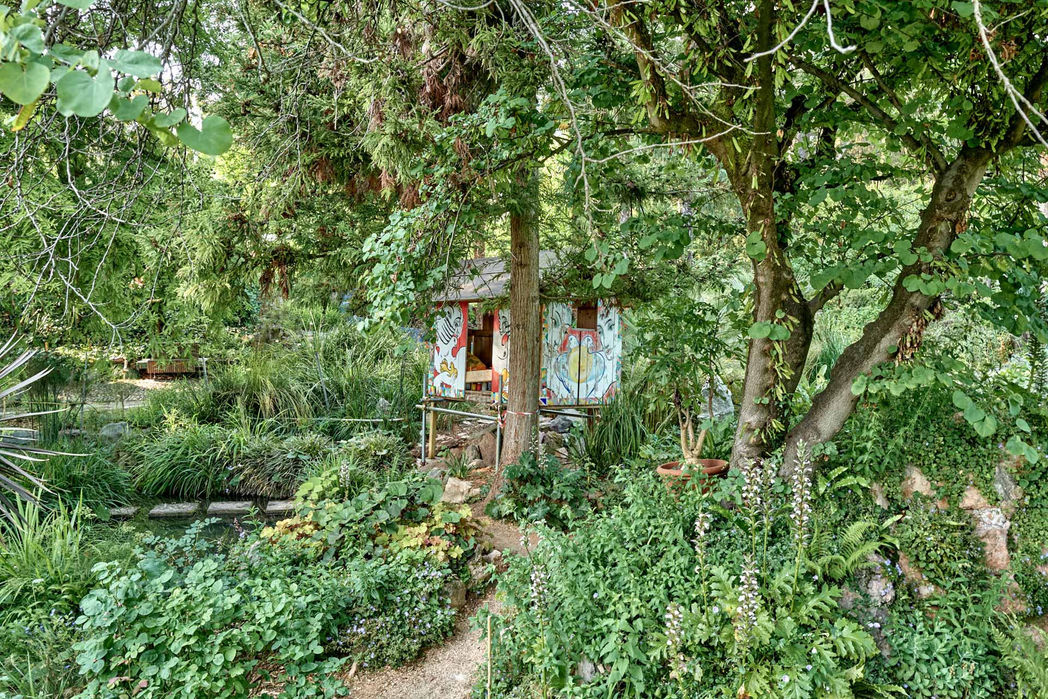Edgar Tezak
Casetta del giochi, 1988
Artwork Brief Description
Tezak’s *Casetta del Giochi* is a whimsical, painted playhouse nestled among the garden’s rocky outcrops. Adorned with surreal imagery of birds, animals, and abstract forms, it explores the boundary between reality and imagination. The artist’s deep interest in human-animal relationships and mythology is evident in his symbolic use of doves and yellow birds. Through its vibrant storytelling, the playhouse encourages childlike wonder while also confronting deeper philosophical themes.




Edgar Tezak (born November 27, 1949 in Graz) is an Austrian painter and graphic artist. He is currently working as a lecturer at the University of Applied Arts Vienna.
Edgar Tezak studied under Hausner at the Academy of Fine Arts in Vienna. Since 1970 he has repeatedly participated in exhibitions. From 1979 to 1994 he worked in New York. From 1990 to 1991, together with André Heller, Werner Herzog filmed the Jagmandir project, the eccentric private theater of the Maharanas of Udaipur, in India. In 1995 Tezak received a teaching position at the University of Applied Arts in Vienna (class Christian Ludwig Attersee).
Edgar Tezak (Austrian b.1949) Casetta del giochi, 1988
Edgar Tezak’s “Casetta del Giochi” is a vibrant and colourful playhouse set amongst a rocky outcrop of the garden. The little house is enveloped by lush green foliage, and the bambooed edging of its structure creates a sense of organic vitality for the sculpture, integrating it seamlessly within its environment. Despite the painted exterior, the playhouse resonates with the surrounding flora and suggests a deliberate interplay between the natural and the created.
Tezak is an artist known for his radical and internationally influenced approach to image-making and storytelling. In his practice, he consistently engages in a profound exploration of what it means to be alive. In doing so, he often looks at both the similarities and differences between humans and animals, and in a recent interview, he said, “I can think, I can speak, animals cannot.”
His interest in the cognitive differences between the species is underscored in this playhouse, where birds occupy a major role in the composition. On one wall, we see a masked woman delicately holding a yellow bird in her hand, whilst above her, what initially appears to be two doves is, upon closer inspection, revealed to be a two-headed dove. Instantly, there is a blurring of real and imagined in Tezak’s narrative, aligning the playhouse with ideas of peace and harmony through the use of doves as symbols of tranquillity and purity whilst simultaneously suggesting a fictitious and surreal alternative world where birds with two heads fly freely.
In Western culture, a yellow bird is understood to symbolise joy and good fortune, whilst, in Hinduism, it is representative of a messenger, leading the soul towards enlightenment and higher spiritual truths. This amalgamation of various sources and influences is typical to Tezak, who spent much of the early 1980s working in India and then moved to New York, where his artistic practice evolved. As a result, his work is a combination of mythology, religion, and his own childhood and personal events. The motifs he uses guide the viewer around the world he creates while allowing them to establish their own narrative.
In one scene, we see a pair of kissing birds, anthropomorphised in their actions and once more challenging our perceptions of nature. There are birds whose bodies appear to blend in with the geometric background that surrounds them and many more birds that perch on branches set within medallion-esque circles. In addition to birds, we see a horse with powdery pale blue patches painted on its body, adding another ethereal element to the composition through this otherworldly, dreamlike imagery.
On the reverse of the playhouse, Tezak presents a poignant tableau: two women intensely gazing at a pair of birds. The woman on the left appears to be a mirror image of the woman on the right, yet she appears markedly more aged and weary, perhaps suggesting the inevitable passage of time and the progression of life.
Tezak’s playhouse is much more than a physical structure in which one could play in. Instead, through his masterful use of motifs drawn from mythology, nature and human life, he encourages the viewer to consider the intricate connections between humans, animals and the environments in which they inhabit.